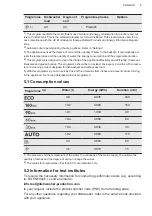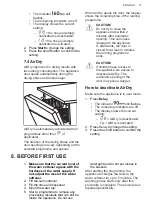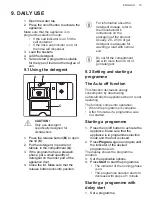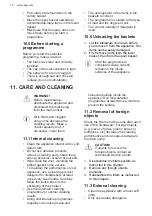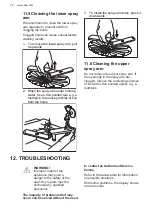
• Soak or slightly scour cookware with
firmly cooked-on or baked-on food
before washing it in the appliance.
• Make sure that items in the baskets
do not touch or cover each other.
Only then can the water completely
reach and wash the dishes.
• You can use dishwasher detergent,
rinse aid and salt separately or you
can use the multi-tablets (e.g. ''All in
1''). Follow the instructions on the
packaging.
• Select a programme according to the
type of load and the degree of soil.
offers the most efficient use of
water and energy consumption.
• To prevent limescale buildup inside
the appliance:
– Refill the salt container whenever
necessary.
– Use the recommended dosage of
the detergent and rinse aid.
– Make sure that the current level of
the water softener agrees with the
hardness of the water supply.
– Follow the instructions in the
chapter "Care and cleaning".
10.2 Using salt, rinse aid and
detergent
• Only use salt, rinse aid and detergent
designed for dishwasher. Other
products can cause damage to the
appliance.
• In areas with hard and very hard
water, we recommend to use basic
dishwasher detergent (powder, gel,
tablets containing no additional
agents), rinse aid and salt separately
for optimal cleaning and drying
results.
• Detergent tablets do not fully dissolve
with short programmes. To prevent
detergent residues on the tableware,
we recommend that you use tablets
with long programmes.
• Always use the correct quantity of
detergent. Insufficient dosage of
detergent can result in poor cleaning
results and hard-water filming or
spotting on the items. Using too much
detergent with soft or softened water
results in detergent residues on the
dishes. Adjust the amount of
detergent based on the water
hardness. Refer to the instructions on
the detergent packaging.
• Always use the correct quantity of
rinse aid. Insufficient dosage of rinse
aid decreases the drying results.
Using too much rinse aid results in
bluish layers on the items.
• Make sure that the water softener
level is correct. If the level is too high,
the increased quantity of salt in the
water might result in rust on cutlery.
10.3 What to do if you want to
stop using multi-tablets
Before you start to use separately
detergent, salt and rinse aid, complete
the following steps:
1. Set the highest level of the water
softener.
2. Make sure that the salt and rinse aid
containers are full.
3. Start the shortest programme with a
rinsing phase. Do not add detergent
and do put dishes in the baskets.
4. When the programme is complete,
adjust the water softener according
to the water hardness in your area.
5. Adjust the released quantity of rinse
aid.
6. Activate the rinse aid empty
notification.
10.4 Loading the baskets
• Always use the whole space of the
baskets.
• Use the appliance to wash
dishwasher-safe items only.
• Do not wash in the appliance items
made of wood, horn, aluminium,
pewter and copper as they could
crack, warp, get discoloured or pitted.
• Do not wash in the appliance items
that can absorb water (sponges,
household cloths).
• Put hollow items (cups, glasses and
pans) with the opening facing
downwards.
• Make sure that glass items do not
touch each other.
• Put light items in the upper basket.
Make sure that the items do not move
freely.
ENGLISH
17
Содержание FFB53617ZM
Страница 1: ...USER MANUAL EN User Manual Dishwasher FFB53617ZM ...
Страница 26: ......
Страница 27: ......
Страница 28: ...www aeg com shop 156812980 A 272022 ...







